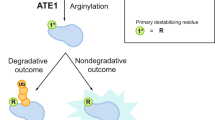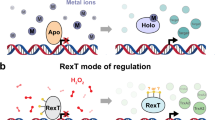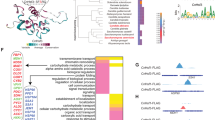Abstract
In Saccharomyces cerevisiae, Yap1 regulates an H2O2-inducible transcriptional response that controls cellular H2O2 homeostasis. H2O2 activates Yap1 by oxidation through the intermediary of the thiol peroxidase Orp1. Upon reacting with H2O2, Orp1 catalytic cysteine oxidizes to a sulfenic acid, which then engages into either an intermolecular disulfide with Yap1, leading to Yap1 activation, or an intramolecular disulfide that commits the enzyme into its peroxidatic cycle. How the first of these two competing reactions, which is kinetically unfavorable, occurs was previously unknown. We show that the Yap1-binding protein Ybp1 brings together Orp1 and Yap1 into a ternary complex that selectively activates condensation of the Orp1 sulfenylated cysteine with one of the six Yap1 cysteines while inhibiting Orp1 intramolecular disulfide formation. We propose that Ybp1 operates as a scaffold protein and as a sulfenic acid chaperone to provide specificity in the transfer of oxidizing equivalents by a reactive sulfenic acid species.
This is a preview of subscription content, access via your institution
Access options
Access Nature and 54 other Nature Portfolio journals
Get Nature+, our best-value online-access subscription
$29.99 / 30 days
cancel any time
Subscribe to this journal
Receive 12 print issues and online access
$259.00 per year
only $21.58 per issue
Buy this article
- Purchase on Springer Link
- Instant access to full article PDF
Prices may be subject to local taxes which are calculated during checkout






Similar content being viewed by others
References
D'Autréaux, B. & Toledano, M.B. ROS as signalling molecules: mechanisms that generate specificity in ROS homeostasis. Nat. Rev. Mol. Cell Biol. 8, 813–824 (2007).
Toledano, M.B., Delaunay, A., Monceau, L. & Tacnet, F. Microbial H2O2 sensors as archetypical redox signaling modules. Trends Biochem. Sci. 29, 351–357 (2004).
Kuge, S., Jones, N. & Nomoto, A. Regulation of yAP-1 nuclear localization in response to oxidative stress. EMBO J. 16, 1710–1720 (1997).
Delaunay, A., Isnard, A.-D. & Toledano, M.B.H. H2O2 sensing through oxidation of the Yap1 transcription factor. EMBO J. 19, 5157–5166 (2000).
Wood, M.J., Andrade, E.C. & Storz, G. The redox domain of the Yap1p transcription factor contains two disulfide bonds. Biochemistry 42, 11982–11991 (2003).
Wood, M.J., Storz, G. & Tjandra, N. Structural basis for redox regulation of Yap1 transcription factor localization. Nature 430, 917–921 (2004).
Kuge, S., Toda, T., Iizuka, N. & Nomoto, A. Crm1 (XpoI) dependent nuclear export of the budding yeast transcription factor yAP-1 is sensitive to oxidative stress. Genes Cells 3, 521–532 (1998).
Yan, C., Lee, L.H. & Davis, L.I. Crm1p mediates regulated nuclear export of a yeast AP-1-like transcription factor. EMBO J. 17, 7416–7429 (1998).
Delaunay, A., Pflieger, D., Barrault, M.B., Vinh, J. & Toledano, M.B. A thiol peroxidase is an H2O2 receptor and redox-transducer in gene activation. Cell 111, 471–481 (2002).
Ma, L.-H., Takanishi, C.L. & Wood, M.J. Molecular mechanism of oxidative stress perception by the Orp1 protein. J. Biol. Chem. 282, 31429–31436 (2007).
Paulsen, C.E. & Carroll, K.S. Chemical dissection of an essential redox switch in yeast. Chem. Biol. 16, 217–225 (2009).
Jencks, W.P. Catalysis in Chemistry and Enzymology, Chapter 1 (Courier Corporation, 1987).
Veal, E.A., Ross, S.J., Malakasi, P., Peacock, E. & Morgan, B.A. Ybp1 is required for the hydrogen peroxide-induced oxidation of the Yap1 transcription factor. J. Biol. Chem. 278, 30896–30904 (2003).
Gulshan, K., Lee, S.S. & Moye-Rowley, W.S. Differential oxidant tolerance determined by the key transcription factor Yap1 is controlled by levels of the Yap1-binding protein, Ybp1. J. Biol. Chem. 286, 34071–34081 (2011).
Patterson, M.J. et al. Ybp1 and Gpx3 signaling in Candida albicans govern hydrogen peroxide-induced oxidation of the Cap1 transcription factor and macrophage escape. Antioxid. Redox Signal. 19, 2244–2260 (2013).
Fomenko, D.E. et al. Thiol peroxidases mediate specific genome-wide regulation of gene expression in response to hydrogen peroxide. Proc. Natl. Acad. Sci. USA 108, 2729–2734 (2011).
Sobotta, M.C. et al. Peroxiredoxin-2 and STAT3 form a redox relay for H2O2 signaling. Nat. Chem. Biol. 11, 64–70 (2015).
Gupta, V. & Carroll, K.S. Sulfenic acid chemistry, detection and cellular lifetime. Biochim. Biophys. Acta 1840, 847–875 (2014).
Devarie-Baez, N.O., Silva Lopez, E.I. & Furdui, C.M. Biological chemistry and functionality of protein sulfenic acids and related thiol modifications. Free Radic. Res. 50, 172–194 (2016).
Tachibana, T. et al. A major peroxiredoxin-induced activation of Yap1 transcription factor is mediated by reduction-sensitive disulfide bonds and reveals a low level of transcriptional activation. J. Biol. Chem. 284, 4464–4472 (2009).
Haynes, A.C., Qian, J., Reisz, J.A., Furdui, C.M. & Lowther, W.T. Molecular basis for the resistance of human mitochondrial 2-Cys peroxiredoxin 3 to hyperoxidation. J. Biol. Chem. 288, 29714–29723 (2013).
Salmeen, A. et al. Redox regulation of protein tyrosine phosphatase 1B involves a sulphenyl-amide intermediate. Nature 423, 769–773 (2003).
Lim, J.C., You, Z., Kim, G. & Levine, R.L. Methionine sulfoxide reductase A is a stereospecific methionine oxidase. Proc. Natl. Acad. Sci. USA 108, 10472–10477 (2011).
Jarvis, R.M., Hughes, S.M. & Ledgerwood, E.C. Peroxiredoxin 1 functions as a signal peroxidase to receive, transduce, and transmit peroxide signals in mammalian cells. Free Radic. Biol. Med. 53, 1522–1530 (2012).
Calvo, I.A. et al. Dissection of a redox relay: H2O2-dependent activation of the transcription factor Pap1 through the peroxidatic Tpx1-thioredoxin cycle. Cell Reports 5, 1413–1424 (2013).
Winterbourn, C.C. & Hampton, M.B. Redox biology: signaling via a peroxiredoxin sensor. Nat. Chem. Biol. 11, 5–6 (2015).
Ghaemmaghami, S. et al. Global analysis of protein expression in yeast. Nature 425, 737–741 (2003).
Webster, M.T., McCaffery, J.M. & Cohen-Fix, O. Vesicle trafficking maintains nuclear shape in Saccharomyces cerevisiae during membrane proliferation. J. Cell Biol. 191, 1079–1088 (2010).
Gutscher, M. et al. Proximity-based protein thiol oxidation by H2O2-scavenging peroxidases. J. Biol. Chem. 284, 31532–31540 (2009).
Zhang, W.-J. et al. Crystal structure of glutathione-dependent phospholipid peroxidase Hyr1 from the yeast Saccharomyces cerevisiae. Proteins 73, 1058–1062 (2008).
Lee, P.Y. et al. Interactome analysis of yeast glutathione peroxidase 3. J. Microbiol. Biotechnol. 18, 1364–1367 (2008).
Langeberg, L.K. & Scott, J.D. Signalling scaffolds and local organization of cellular behaviour. Nat. Rev. Mol. Cell Biol. 16, 232–244 (2015).
Mulrooney, S.B. Application of a single-plasmid vector for mutagenesis and high-level expression of thioredoxin reductase and its use to examine flavin cofactor incorporation. Protein Expr. Purif. 9, 372–378 (1997).
Mössner, E., Huber-Wunderlich, M. & Glockshuber, R. Characterization of Escherichia coli thioredoxin variants mimicking the active-sites of other thiol/disulfide oxidoreductases. Protein Sci. 7, 1233–1244 (1998).
Boschi-Muller, S. et al. A sulfenic acid enzyme intermediate is involved in the catalytic mechanism of peptide methionine sulfoxide reductase from Escherichia coli. J. Biol. Chem. 275, 35908–35913 (2000).
Roussel, X. et al. Evidence for the formation of a covalent thiosulfinate intermediate with peroxiredoxin in the catalytic mechanism of sulfiredoxin. J. Biol. Chem. 283, 22371–22382 (2008).
Oganesyan, N., Ankoudinova, I., Kim, S.-H. & Kim, R. Effect of osmotic stress and heat shock in recombinant protein overexpression and crystallization. Protein Expr. Purif. 52, 280–285 (2007).
Studier, F.W. Protein production by auto-induction in high density shaking cultures. Protein Expr. Purif. 41, 207–234 (2005).
Sikorski, R.S. & Hieter, P. A system of shuttle vectors and yeast host strains designed for efficient manipulation of DNA in Saccharomyces cerevisiae. Genetics 122, 19–27 (1989).
Neuhoff, V., Arold, N., Taube, D. & Ehrhardt, W. Improved staining of proteins in polyacrylamide gels including isoelectric focusing gels with clear background at nanogram sensitivity using Coomassie Brilliant Blue G-250 and R-250. Electrophoresis 9, 255–262 (1988).
Boukhenouna, S. et al. Evidence that glutathione and the glutathione system efficiently recycle 1-cys sulfiredoxin in vivo. Antioxid. Redox Signal. 22, 731–743 (2015).
Acknowledgements
We gratefully acknowledge G. Branlant for his essential input to initiate the project. We also thank A. Gruez for assistance with protein stability optimization; S. Boschi-Muller and F. Talfournier for fruitful discussions and help with quench flow experiments; J.M. Alberto for support with the use of the NGERE U954-INSERM chromatographic facility; and J. Charbonnel and G. Palais for excellent technical support. Microcalorimetry and mass spectrometry were performed respectively at the SCBIM (Fédération de Recherche 3209 BMCT) and SCMS platforms of Université de Lorraine. This work was supported by grants from the Ligue contre le Cancer to S.R.-C., and from ANR ERRed, InCA PLBIO INCA_5869 to M.B.T. A.B. was supported by a PhD fellowship from the French research minister.
Author information
Authors and Affiliations
Contributions
A.B., B.d'A., M.B.T., and S.R.-C. designed the experiments and analyzed the data. A.B., A.K., and B.d'A. produced and purified the proteins, A.B. and B.d'A. performed in vitro reconstitution assays, B.d'A. on gels kinetics and A.B. all other kinetics; H.M. and A.B. performed chromatography and mass spectrometry analyses; A.B. and A.K. performed protein interaction experiments. G.B., B.d'A., and A.D.-M. carried out in vivo experiments. S.R.-C., B.d'A., and M.B.T. wrote the manuscript.
Corresponding authors
Ethics declarations
Competing interests
The authors declare no competing financial interests.
Supplementary information
Supplementary Text and Figures
Supplementary Results, Supplementary Tables 1–2 and Supplementary Figures 1–12 (PDF 2217 kb)
Rights and permissions
About this article
Cite this article
Bersweiler, A., D'Autréaux, B., Mazon, H. et al. A scaffold protein that chaperones a cysteine-sulfenic acid in H2O2 signaling. Nat Chem Biol 13, 909–915 (2017). https://doi.org/10.1038/nchembio.2412
Received:
Accepted:
Published:
Issue Date:
DOI: https://doi.org/10.1038/nchembio.2412
This article is cited by
-
Reaction-based fluorogenic probes for detecting protein cysteine oxidation in living cells
Nature Communications (2022)
-
Oxidative stress response pathways in fungi
Cellular and Molecular Life Sciences (2022)
-
A role for annexin A2 in scaffolding the peroxiredoxin 2–STAT3 redox relay complex
Nature Communications (2020)
-
Scaffolding H2O2 signaling
Nature Chemical Biology (2017)



